|
|
The Lukut Massacres
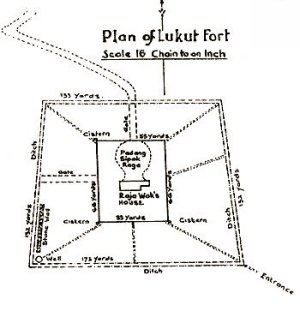 It is thought that the civil war that erupted in Selangor
after the death
of Sultan Muhammad may well have been avoided had there not been a
dispute
in the succession. According to the Victorian traveller Isabella Bird,
it
was recognized that Sultan Muhammad had no legitimate offspring, "but
it
was likely that at his death, his near relation, Tunku Bongsu, a Rajah
universally-liked
and respected by his countrymen would have been elected to succeed
him."
Unfortunately for Selangor, the fate of 'Tunku Bongsu', more widely
known
as Raja Busu, was to prove as tragic as that of his State. It is thought that the civil war that erupted in Selangor
after the death
of Sultan Muhammad may well have been avoided had there not been a
dispute
in the succession. According to the Victorian traveller Isabella Bird,
it
was recognized that Sultan Muhammad had no legitimate offspring, "but
it
was likely that at his death, his near relation, Tunku Bongsu, a Rajah
universally-liked
and respected by his countrymen would have been elected to succeed
him."
Unfortunately for Selangor, the fate of 'Tunku Bongsu', more widely
known
as Raja Busu, was to prove as tragic as that of his State.
Raja Busu was a son of Sultan Muhammad who, in 1824,came to Lukut with
his
followers from Selangor, Kedah and other States to develop its rich tin
resources.
He encouraged Chinese miners, especially from Melaka, to settle in the
area
and work the tin mines. He was an effective administrator and Lukut
prospered,
with more and more Chinese miners arriving and expanding the output of
the
mines.
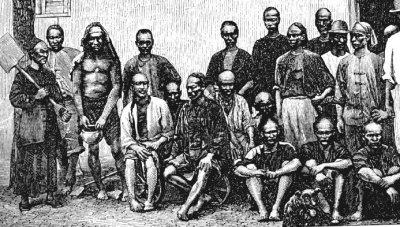
In 1834, Raja Busu decided to impose a ten per cent levy on
all
tin extracted and exported from Lukut. This greatly angered the local
Chinese
miners, as well as their financial backers in Melaka. One dark, rainy
night
in September, 1834, this anger erupted into rage when some 300-400
Chinese
converged upon Raja Busu's palace and surrounded it, angrily shouting
and
demanding that he either come out or they would set fire to his home.
Raja
Busu defiantly shouted back "Muslims are not afraid to die - do what
you
like!"
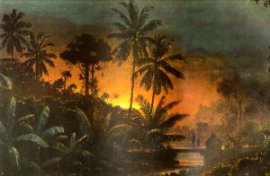 Upon hearing this, the mob attacked
the Palace and the houses of Malays nearby,
with hundreds being robbed and killed. Not a single soul in the palace
survived.
In the words of Isabella Bird, "these miners rose upon their
employers,
burned their houses, and massacred them indiscriminately, including
this
enlightened Rajah; and his wife and children, in attempting to escape,
were
thrown into the flames of their house. The plunder obtained by the
Chinese,
exclusive of the jewels and gold ornaments of the women, was estimated
at
3,500 pounds. This very atrocious business was believed to have been
aided
and abetted, if not absolutely concocted, by Chinese merchants living
under
the shelter of the British flag at Malacca." Upon hearing this, the mob attacked
the Palace and the houses of Malays nearby,
with hundreds being robbed and killed. Not a single soul in the palace
survived.
In the words of Isabella Bird, "these miners rose upon their
employers,
burned their houses, and massacred them indiscriminately, including
this
enlightened Rajah; and his wife and children, in attempting to escape,
were
thrown into the flames of their house. The plunder obtained by the
Chinese,
exclusive of the jewels and gold ornaments of the women, was estimated
at
3,500 pounds. This very atrocious business was believed to have been
aided
and abetted, if not absolutely concocted, by Chinese merchants living
under
the shelter of the British flag at Malacca."
As survivors fled into the countryside and news of the atrocity spread,
Malays
in the region converged upon Lukut. The Chinese attempted to escape
over
the border to British Melaka - but they were ambushed and killed.
Villages and mines
in Lukut were deserted for years.
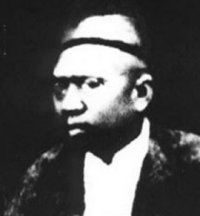 In 1846, a Bugis prince from Riau, Raja Jumaat, was
officially appointed by the Sultan
to rule Lukut on his behalf. While Raja Jumaat made great efforts in
trying
to win the support of locals and miners, he was also mindful of the
district's
bloody history and firmly stamped his authority. There was no clearer
reminder
of this authority than the construction of a fort in 1847 that, today,
remains
as one of the most well-preserved Bugis forts in existence. In 1846, a Bugis prince from Riau, Raja Jumaat, was
officially appointed by the Sultan
to rule Lukut on his behalf. While Raja Jumaat made great efforts in
trying
to win the support of locals and miners, he was also mindful of the
district's
bloody history and firmly stamped his authority. There was no clearer
reminder
of this authority than the construction of a fort in 1847 that, today,
remains
as one of the most well-preserved Bugis forts in existence.
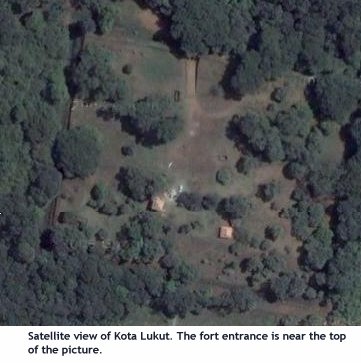 The fort is located on the summit of a hill known as Bukit
Gajah Mati (Hill
of the Dead Elephant) or Bukit Raja, and was accessible by a winding
road
from the foot of the hill. The fort overlooks Lukut town and gave an
unhindered
view of the Lukut river, its surroundings and even the Straits of
Melaka. The fort is located on the summit of a hill known as Bukit
Gajah Mati (Hill
of the Dead Elephant) or Bukit Raja, and was accessible by a winding
road
from the foot of the hill. The fort overlooks Lukut town and gave an
unhindered
view of the Lukut river, its surroundings and even the Straits of
Melaka.
Built by convict labour, it was square in shape and measured
about
200 metres by 170 metres.
Its red laterite stone walls were surrounded by a moat eight
metres
wide and between eight to ten metres deep. A forest of bamboo stakes
were
planted at the bottom of the moat and the barricaded stone walls were
ringed
with the latest Dutch-made cannons. Cannon were also placed at the main
entrance
to the fort, on the north wall, and a smaller entrance on the west
wall.
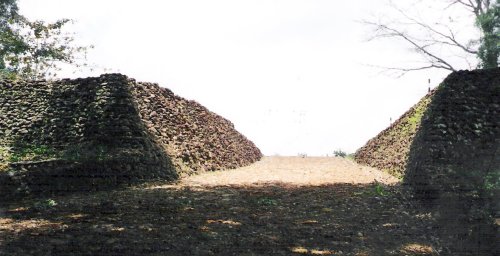
The fort was further enlarged and fortified during the reign
of
Raja Bot, Raja Jumaat's son, and the Malay garrison stationed there was
strengthened
with the employment of 30 Arab mercenaries. A 'sepak raga' court within
the
fort provided the garrison with sporting entertainment.
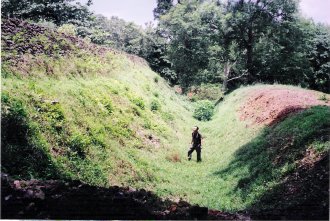 The British Resident of Melaka, Captain MacPherson,
reported that the troops
in Kota Lukut wore uniforms similar to those found in Melaka and that
their
conduct was "very orderly and disciplined" The British Resident of Melaka, Captain MacPherson,
reported that the troops
in Kota Lukut wore uniforms similar to those found in Melaka and that
their
conduct was "very orderly and disciplined"
A palace was built in the middle of the Fort for Raja Wok, the
daughter
of Raja Jumaat. Water pools were located at each corner of the fort's
perimeter,
which were replenished with water brought from the river up to the fort
by
bullock cart.
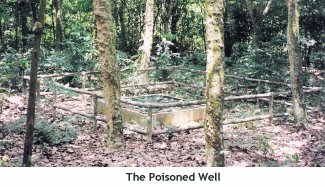 However, the royal household had exclusive use
of a walled well, called the
Princess' Well, which was under guard at all times. Another well
located
outside the fort was called the Perigi Beracun or Poisoned Well, and
was
used for the execution of criminals, who were lowered down the shaft
into
a deadly mix of water, latex and poisonous tree saps. However, the royal household had exclusive use
of a walled well, called the
Princess' Well, which was under guard at all times. Another well
located
outside the fort was called the Perigi Beracun or Poisoned Well, and
was
used for the execution of criminals, who were lowered down the shaft
into
a deadly mix of water, latex and poisonous tree saps.
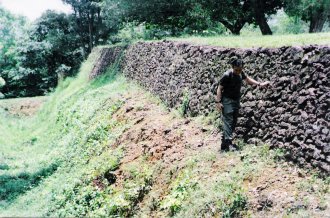 Raja Jumaat's reign was one of peace and growing
prosperity and ended with
his death in 1864. During Raja Bot's reign, however, Raja Sulaiman of
Sungai
Raya attempted to overrun Lukut, resulting in the fort being used as a
refuge
for women and children fleeing hostilities. Raja Jumaat's reign was one of peace and growing
prosperity and ended with
his death in 1864. During Raja Bot's reign, however, Raja Sulaiman of
Sungai
Raya attempted to overrun Lukut, resulting in the fort being used as a
refuge
for women and children fleeing hostilities.
A battle ensued at Kampong Cina and Raja Bot's forces had to
withdraw
to the fort when every one his Arab mercenaries fled the field after
one of their number
was killed in the fighting. However, the fort's Malay defenders
forcefully threw
back Raja Sulaiman's assault and he was forced to flee back to Sungai
Raya.
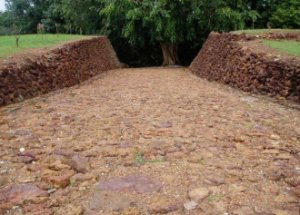 Further unrest bewteen Malays and Chinese in later years,
as well as dwindling
tin production, led to Lukut's slow decline. By the time Lukut fell
under
the control of Sungai Ujong in 1878, it was in financial ruin and the
fort
was abandoned. Further unrest bewteen Malays and Chinese in later years,
as well as dwindling
tin production, led to Lukut's slow decline. By the time Lukut fell
under
the control of Sungai Ujong in 1878, it was in financial ruin and the
fort
was abandoned.
Sources:
- “Kota-Kota Melayu”, Abdul Halim Nasir, 1990, Dewan
Bahasa dan Pustaka
- “Sejarah Selangor”, Haji Buyong Adil, 1981, Dewan
Bahasa dan Pustaka
- "A History of Selangor" J M Gullick, 1998, Malaysian
Branch
of the Royal Asiatic Society Monograph No. 28
- "The Golden Chersonese" Isabella Bird, 1883, John
Murray
Write to the author: sabrizain@malaya.org.uk
The
Sejarah Melayu
website is
maintained solely by myself and does not receive any funding
support from any governmental, academic, corporate or other
organizations. If you have found the Sejarah Melayu website useful, any
financial contribution you can make, no matter how small, will be
deeply appreciated and assist greatly in the continued maintenance of
this site.
|
|


